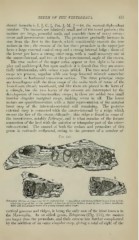Page 461 - My FlipBook
P. 461
TEETH OF THE VERTEBBATA. 471
dental formula is I, |, C. \, Pm. ^, M. = 44, the normal diphyodbnt
f
number. The incisors are relatively small and of the usual pattern ; the
canines are large, powerful teeth, and resemble those of many carniv-
orous and insectivorous animals. The premolars gradually increase in
size from the first to the fourth, which considerably exceeds the true
molars in size ; the crowns of the last three premolars in the upper jaw
have a large external conical cusp and a strong internal ledge ; those of
the lower jaw have a strong outer cusp, with a small accessory one at
the antero-internal, and two at the postero-internal, angle of the crown.
The true molars of the upper series appear at first sight to be com-
plex and multicuspid, but upon analysis it is found that they are essen-
tially tritubercidar, with minor cusps added. The two usual external
cusps are present, together with one large internal tubercle somewhat
crescentic in horizontal transverse section. The three principal cusps
iu*e homologous with the three cusps of the molar teeth of many of the
Insectivora already mentioned, and like them are placed in the form of
a triangle, but the two horns of the crescent are interrupted by the
development of two intermediate cusps ; to these are added two small
interior cingular marginal cusps, making seven in all. The lower
molars are quadritul)ercular, with a faint representation of the anterior
basal cusp of the tuljerculo-sectorial still remaining. The postero-
external cusp is connected ^\•ith the antero-internal by a ridge which
crosses the face of the crown obliquely ; this ridge is found in some of
the insectivores, notably Esthonyx, and is what remains of the former
connection of the heel with the anterior or triangular part of the tuber-
culo-sectorial. The enamel of both the molars and premolars of this
genus is curiously sculptured, owing to the presence of a number of
Fig
Ectoconits dilrigdiiiis, Cupt', two-tliuds natural size: ", maxillary and jiitni i\ill n \ Ixint- \i mi lulon,
retaining a good deal ol' the matrix; h, last two interior molars, worn bj use, (, thiee deciduous
with first permanent molar of a young animal (after Cope).
vertical grooves and ridges, it being the only case of the kind known in
the Mammalia. In an allied genus, Edoganus (Fig. 251), the molars
are larger than the premolars, and their crowns are further complicated
by the addition of an outer cingular cusp, giving a total of eight of the


